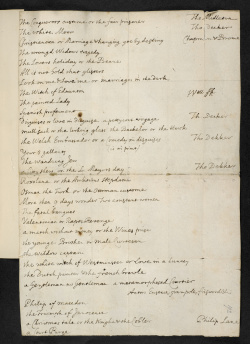White Witch of Westminster, The
Anon. (Jacobean or Caroline)
Historical records
The twenty-fifth item on Hill's List of Early Plays in Manuscript is:
- The white witch of Westminster or Love in a Lunacy
Theatrical provenance
This play is not known except on Hill's List, and therefore cannot be ascribed to a particular company or dated beyond Bentley's usual formula: "The list seems to have been Hill's record of the stock of some bookseller, set down between 1677 and 1703, but it is notable that nearly all the identifiable plays and playwrights of the list are Jacobean or Caroline" (Bentley, V.1283).
Genre
Love comedy / witchcraft play (Adams); historical? (see below)
Possible Narrative and Dramatic Sources or Analogues
None known (but see For What It's Worth)
References to the play
None known
Critical Commentary
J. Q. Adams comments:
- Possibly this play treated of some ' wise woman ' of Westminster who concerned herself with the love affairs of a young couple, very much as in Heywood's The Wise Woman of Hogsdon. A lost play called Long Meg of Westminster, recorded by Henslowe as acted by the Admiral's Men at the Rose between 1595 and 1597, was still popular on the London stage as late as 1611; but a reading of the prose pamphlet, The Life of Long Meg of Westminster, 1582 (a greatly expanded version, 1635), fails to disclose any feature that would make the title cited by Hill applicable.
- (Adams, 91).
Bentley recaps what Adams says without adding anything further. (5.1440)
For what it's worth
Long Meg of Westminster certainly wasn't a witch. See Bernard Capp's 1998 article identifying the historical figure in question.
The White Witch of Westminster belongs to a distinct sub-sub-genre: plays whose titles describe a witch living on the outskirts of London. As well as The Wise Woman of Hogsdon, one could mention The Witch of Edmonton, the lost The Witch of Islington, and possibly also the lost Mother Redcap.
In addition, I don't believe that it has been previously linked with this lost play, but there was one famous historical witchcraft case associated with the Westminster area. This was that of Margery Jourdemayne, "the Witch of Eye next Westminster", who allegedly performed magical divination for Eleanor, wife of Humphrey Duke of Gloucester, and who was burnt to death in 1441. Jessica Freeman's article offers a detailed analysis both of the case, and of some of the numerous literary allusions to the scandal. The Mirror for Magistrates (1560), for instance, describes the witch in the following terms:
- There was a Beldame called the wytch of Ey,
- Old mother Madge her neyghbours did hir name
- Which wrought wonders in countryes by heresaye
- Both feendes and fayries her charmyng would obay
- And dead corpsis from grave she could uprere
- Suche an inchauntresse, as that tyme had no peere.
(Cited from Freeman, 344).
However, there is also, in sources such as the Mirror for Magistrates, considerable sympathy for all those involved, since, as Samuel Pratt has explored, the generous and chivalrous Humphrey Duke of Gloucester enjoyed something of the status of a folk hero in Shakespearean England. Thus, in the Mirror For Magistrates narrative, Eleanor describes how she asked the witch to forecast who would succeed King Henry, adding that she asked her to do nothing worse than this. This crime, however, was enough for Eleanor's enemies to work with: they had the witch and her helpers burnt to death, and Eleanor disgraced and banished, as a way of hurting Humphrey. Eleanor's difficulties with accusations of witchcraft are, of course, actually staged in Shakespeare's 1 Henry VI, in which Humphrey is a major character. (See also the LPD entry on the lost play Duke Humphrey).
As it stands, this connection is by no means enough to show that The White Witch of Westminster was indeed a historical melodrama featuring Margery Jourdemayne and Eleanor Cobham. But it is, perhaps, enough to suggest that any play about a witch based in Westminster might, for early modern audiences, have been coloured by the events of 1441.
Works Cited
Adams, Joseph Quincy. “Hill’s List of Early Plays in Manuscript.” The Library 4th Ser., 20.1 (1939): 71-99.
Capp, Bernard. "Long Meg Of Westminster: A Mystery Solved", Notes and Queries 45 (1998): 302-304.
Freeman, Jessica. "Sorcery at court and manor: Margery Jourdemayne, the witch of Eye next Westminster". Journal of Medieval History 30.4 (2004): 343-357.
Harriss, G. L. ‘Eleanor, duchess of Gloucester (c.1400–1452)’, Oxford Dictionary of National Biography, Oxford University Press, Sept 2004; online edn, Jan 2008 accessed 11 Dec 2009
Pratt, Samuel M. "Shakespeare and Humphrey Duke of Gloucester: A Study in Myth". Shakespeare Quarterly 16.2 (1965): 201-216.
Site created and maintained by Matthew Steggle, Sheffield Hallam University. Updated 8 January 2016.
